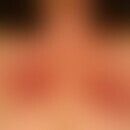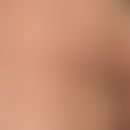Synonym(s)
HistoryThis section has been translated automatically.
Darier 1896
DefinitionThis section has been translated automatically.
The term tuberculid is a historical term under which a series of abacterial reactions (so-called"Id reaction"of the skin/now an obsolete term) to tuberculoantigenic material was summarized. The criteria for classification as a tuberculid are still valid today:
- History or simultaneous manifestation of organ tuberculosis.
- Typical macro- or micromorphological substrate
- Strongly positive intracutaneous tuberculin test
- Healing after antituberculous therapy.
You might also be interested in
ClassificationThis section has been translated automatically.
Today, the following clinical pictures are assigned to the term "tuberculid":
- Papulonecrotic tuberculid (Folliculitis de Barthélemy)
- Lichenoid skin tuberculosis
- Erythema induratum (Bazin/syn. nodular vasculitis).
EtiopathogenesisThis section has been translated automatically.
An immunological reaction of the type III immune complex type or type IV late type according to Coombs and Gell is probably present. In this case, hematogenously spread antigens of mycobacteria in the skin induce a protracted inflammation. These patients often have active organ tuberculosis without an anatomical relationship to the tuberculides. Typically, cultural cultures from lesional tissue are negative! It is true that the tuberculides heal under antituberculous therapy. However, the anti-inflammatory effect of antibiotics must also be taken into account.
ClinicThis section has been translated automatically.
LaboratoryThis section has been translated automatically.
HistologyThis section has been translated automatically.
TherapyThis section has been translated automatically.
LiteratureThis section has been translated automatically.
- Chen Q et al. (2019) Cutaneous tuberculosis: A great imitator. Clin Dermatol 37:192-199.
- Connors WJ det al.Program-wide review and follow-up of erythema Induratum of Bazin andtuberculosis-associated ocular inflammation management in a TB low-incidencesetting: need for improved treatment candidate selection, therapy standardization, and care collaboration.Infect Dis 19:97.
- Darier J (1896) Des tuberculides cutanèes. Ann Derm Syph 7: 1431-1436
- Fernandes NC et al. (2023) Erythema induratum of Bazin. Rev Soc Bras Med Trop 56:e0465.
- Joshi HS et al (2014) Lichen scrofulosorum. BMJ Case Rep:bcr2013200858. doi: 10.1136/bcr-2013-200858.
- Meghana V et al (2017) Papulonecrotic tuberculid. Am J Trop Med Hyg 97:987-988.
- Pramatarow K et al (1991) Papulonecrotic tuberculid case report. Z Hautkr 67: 62-64
- Thappa DM et al. (2003) Tuberculid in a child: transformation from papulonecrotic to lichen scrofulosorum. Pediatr Dermatol 20: 91-93
Incoming links (6)
Acnitis; Id reaction; Lichenoid tuberculid; Nodular vasculitis; Papulonecrotic tuberculid; Syphilide papular;Outgoing links (10)
Allergy (overview); Cutaneous tuberculosis; Erythema nodosum; Granuloma, tuberculoids; Id reaction; Lichenoid tuberculid; Nodular vasculitis; Papulonecrotic tuberculid; Tuberculosis cutis luposa; Vasculitis leukocytoclastic (non-iga-associated);Disclaimer
Please ask your physician for a reliable diagnosis. This website is only meant as a reference.







